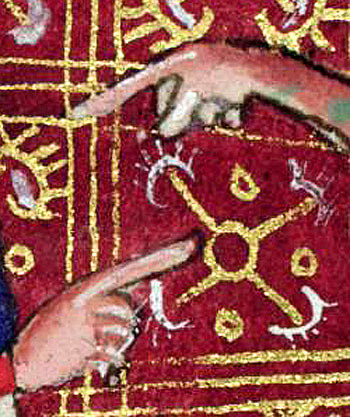Sir Launfal
General Information
Plot Summary

King Arthur’s steward, Sir Launfal, is loved for his generosity but disapproves of his lord’s marriage to Guinevere because of her promiscuous reputation. At the wedding feast, the new queen gives rich gifts to all the knights except Launfal. He makes his excuses and leaves the court, taking Arthur’s two nephews with him. They travel to Caerleon where the mayor, his former servant, reluctantly gives them lodgings. Launfal falls into debt and his companions, tired of living in poverty, return to court. On Launfal’s request they conceal his hardship from the king; Guinevere is annoyed to hear that the knight is doing well.
The mayor holds a great feast on Trinity Sunday, but Launfal is not invited. His lack of decent clothes prevents him from going to church, but he borrows a saddle and bridle from the mayor’s daughter. Despite mockery from the citizens, he rides to a forest and lies down to rest. There he is greeted by two beautiful maidens on behalf of their mistress Triamour, daughter of the fairy king. He follows them to a rich pavilion, where the dazzlingly beautiful half-clothed fairy declares her love for him and offers him magical gifts, a horse and a squire. He accepts, they dine and go to bed. In the morning, she warns him to keep their love a secret – if he boasts about her he will lose her.
Launfal returns to Caerleon. He snubs the hypocritical mayor, then pays off his debts, holds rich feasts and helps the poor, while his lover visits him nightly. He wins a tournament held in his honour and travels to Lombardy to defeat the fearsome Sir Valentine. Arthur hears of Launfal’s success and invites him to a feast, reinstating him as steward. Guinevere propositions the knight during a dance and, when he refuses, accuses him of loving no woman. Launfal responds that the lowliest maid of his lover is more beautiful than Guinevere, thus enraging the queen and breaking his promise to Triamour. His riches disappear and Arthur threatens to hang him after the queen claims that he approached her and, rejected, invented a mistress. A jury of knights decide that, considering the reputation of the queen, Launfal should be acquitted if he can produce his lover. Guinevere replies that if he produces a fairer woman, she will be blinded.
On the appointed day, the knight admits that he cannot summon his lover and awaits punishment. Twenty beautiful maidens enter the court and approach the king, but Launfal admits that none of them are his lady. Sensing that her downfall is near, Guinevere urges the king to punish him. But then Triamour herself rides into the court, beautifully clothed and riding a bejewelled horse. She bids Arthur punish the queen, who is ugly in comparison. The court agrees, and Triamour blinds Guinevere. She and Launfal leave the court and ride to the fairy Isle of Oliroun where he remains for the rest of his days. Once a year he mysteriously appears to joust.
From: Donald Sands, Middle English Verse Romances. Exeter: University of Exeter Press, 1986.
Manuscript: London, British Library, MS Cotton Caligula Aii.
Manuscripts
Click a title below to search for all romances in that manuscript.